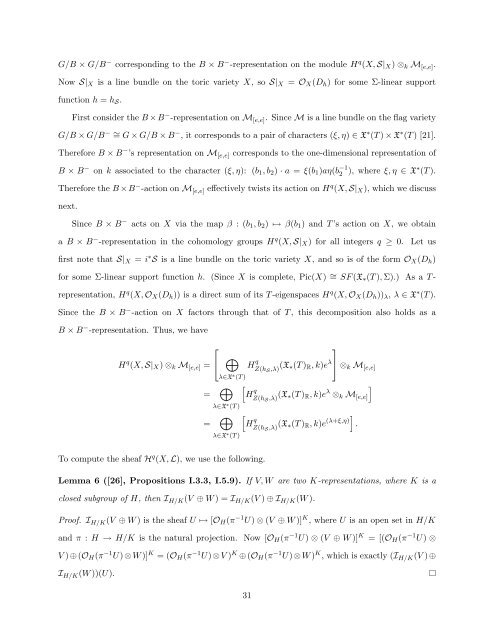Equivariant Embeddings of Algebraic Groups
Equivariant Embeddings of Algebraic Groups
Equivariant Embeddings of Algebraic Groups
You also want an ePaper? Increase the reach of your titles
YUMPU automatically turns print PDFs into web optimized ePapers that Google loves.
G/B × G/B − corresponding to the B × B − -representation on the module H q (X, S| X ) ⊗ k M [e,e] .<br />
Now S| X is a line bundle on the toric variety X, so S| X = O X (D h ) for some Σ-linear support<br />
function h = h S .<br />
First consider the B ×B − -representation on M [e,e] . Since M is a line bundle on the flag variety<br />
G/B × G/B − ∼ = G × G/B × B − , it corresponds to a pair <strong>of</strong> characters (ξ, η) ∈ X ∗ (T ) × X ∗ (T ) [21].<br />
Therefore B × B − ’s representation on M [e,e] corresponds to the one-dimensional representation <strong>of</strong><br />
B × B − on k associated to the character (ξ, η): (b 1 , b 2 ) · a = ξ(b 1 )aη(b −1<br />
2 ), where ξ, η ∈ X∗ (T ).<br />
Therefore the B ×B − -action on M [e,e] effectively twists its action on H q (X, S| X ), which we discuss<br />
next.<br />
Since B × B − acts on X via the map β : (b 1 , b 2 ) ↦→ β(b 1 ) and T ’s action on X, we obtain<br />
a B × B − -representation in the cohomology groups H q (X, S| X ) for all integers q ≥ 0.<br />
Let us<br />
first note that S| X = i ∗ S is a line bundle on the toric variety X, and so is <strong>of</strong> the form O X (D h )<br />
for some Σ-linear support function h. (Since X is complete, Pic(X) ∼ = SF (X ∗ (T ), Σ).) As a T -<br />
representation, H q (X, O X (D h )) is a direct sum <strong>of</strong> its T -eigenspaces H q (X, O X (D h )) λ , λ ∈ X ∗ (T ).<br />
Since the B × B − -action on X factors through that <strong>of</strong> T , this decomposition also holds as a<br />
B × B − -representation. Thus, we have<br />
⎡<br />
H q (X, S| X ) ⊗ k M [e,e] = ⎣<br />
⊕<br />
λ∈X ∗ (T )<br />
= ⊕<br />
λ∈X ∗ (T )<br />
= ⊕<br />
λ∈X ∗ (T )<br />
H q Z(h S ,λ) (X ∗(T ) R , k)e λ ⎤<br />
⎦ ⊗ k M [e,e]<br />
[H q Z(h S ,λ) (X ∗(T ) R , k)e λ ⊗ k M [e,e]<br />
]<br />
[<br />
H q Z(h S ,λ) (X ∗(T ) R , k)e (λ+ξ,η)] .<br />
To compute the sheaf H q (X, L), we use the following.<br />
Lemma 6 ([26], Propositions I.3.3, I.5.9). If V, W are two K-representations, where K is a<br />
closed subgroup <strong>of</strong> H, then I H/K (V ⊕ W ) = I H/K (V ) ⊕ I H/K (W ).<br />
Pro<strong>of</strong>. I H/K (V ⊕ W ) is the sheaf U ↦→ [O H (π −1 U) ⊗ (V ⊕ W )] K , where U is an open set in H/K<br />
and π : H → H/K is the natural projection. Now [O H (π −1 U) ⊗ (V ⊕ W )] K = [(O H (π −1 U) ⊗<br />
V ) ⊕ (O H (π −1 U) ⊗ W )] K = (O H (π −1 U) ⊗ V ) K ⊕ (O H (π −1 U) ⊗ W ) K , which is exactly (I H/K (V ) ⊕<br />
I H/K (W ))(U).<br />
31
















